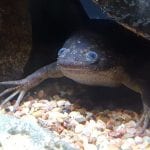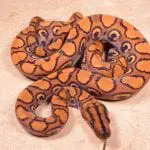Scientific Facts
| Common Name | Blanding’s Turtle |
| Scientific Name | Emys blandingii or Emydoidea blandingii |
| Life Span | 80 years |
| Size | 18 to 23 cm in length |
| Habitat | Wetlands where there is clean, shallow water |
| Country of Origin | Great Lakes, Nebraska, and Minnesota in the U.S. |
Physical Description
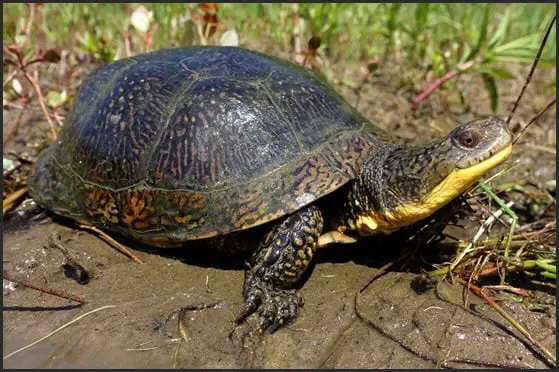
Blanding’s turtle is a species of turtle that is native to Canada in the southeastern part of Ontario and southern Nova Scotia. This turtle has an expansive geographic range that goes as far as Maine, North Dakota, and Nebraska.
Blanding’s turtle is semi-aquatic and lives in shallow wetlands where there is abundant aquatic vegetation. This is a wise choice of habitat because it wants to keep away from its predators that control the wetlands. Their homes are in the grasslands near freshwater sources.
This turtle comes with a smooth shell that may range from brown to black. You will find distinct yellow markings along with their dorsal shells. Adult yellow-bellied sliders come with plastrons with black and yellow marks. The most common have yellow with black spots on the scutes.
Adult turtles have shells that are as big as 150 to 240 mm. These turtles weigh from 750 to 1400 grams. These turtles have flat heads, while the dorsal and side are colored bluish-gray. These turtles have protruding eyes, but the snouts don’t. The legs and tails have yellow scales while the toes are webbed.
Male and female Blanding’s turtles have almost the same size, but the plastrons of males are more concave compared to females. Meanwhile, eastern box turtles look almost similar to the Blanding’s turtle, but the latter is distinguished by a light yellow color found along the ventral area of the throat. These have long necks with dark areas found along the upper area of the jaw. Meanwhile, the eastern box turtle has a yellow spot along the chin and not along the throat and the neck. Blanding’s turtles are known to be bigger and heavier than eastern box turtles
Females have higher shells than males, while males have wider shells compared to their female counterparts. Males mostly have eroded shells with visible pits. Compared to other turtle species, females have these present on their shells, especially when the female is actively breeding. Females use their shells to develop healthy eggs. Also, male Blanding’s turtles may be distinguished from females by the light yellow color on their mouth. Females don’t possess this unique mark.
Life Span
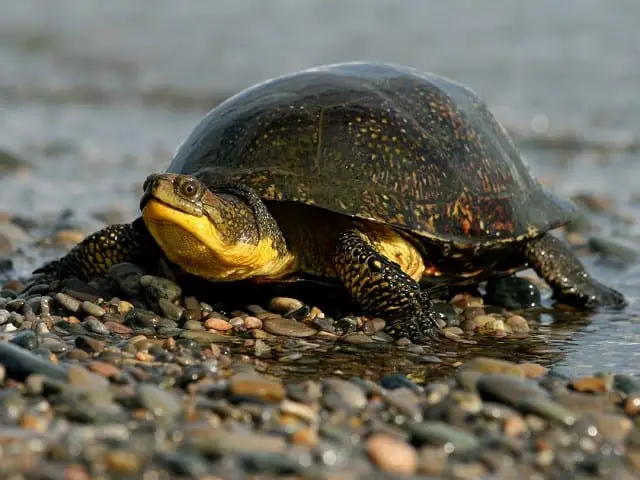
Blanding’s turtle can reach a ripe age of 80 when properly cared for. Like other turtles, temperature plays a huge role in determining the sex of Blanding’s turtles. When eggs are laid in nests in a cooler area, the hatchlings are males. Meanwhile laying the eggs in a warmer area will produce females.
Blanding’s turtle has three stages of development: hatchlings, juveniles, and adults
Hatchlings
Hatchlings are very small, measuring only 29 to 39 mm and will weigh only 10 grams. The shells of baby turtles are rounder but may soon become flat as they grow older.
Juveniles
Juvenile Blanding’s turtle will have rapid growth during this stage. Their plastrons and carapaces will become longer while their abdominal plats will grow up to 70% during their first year of life. The rate of growth of these turtles will be amazing over the next three to four years. The juveniles will now look very similar to their parents and have become more experienced hunters.
At two years of age, the hinges of the turtle’s ventral shells are still moving to adjust to the size of the growing turtle. These hinges will close when the turtles reach five years old.
Adults
At the turtle’s 4th year of life, it has already reached its full adult size. The age may be determined by counting the number of annuli on the turtle’s shell. Annuli are rings similar to tree rings and are found on the shells of the turtle.
Breeding happens all year round but mostly early spring till early April. The females are sexually mature around 14 to 21 years, and this happens after an overwintering period. Males reach sexual maturing faster at around 12 years.
Eating Habits
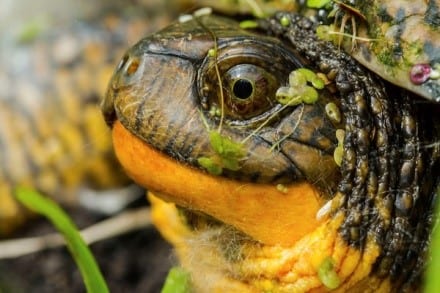
Blanding’s turtles will eat plants and animals. Half of their diet are crustaceans, such as crayfish. These turtles will eat their food alive. They will also eat other invertebrates like insects. And if their favorite food is not available, Blanding’s turtle will resort to dragonfly nymphs and beetles. It can also eat fish eggs, frogs, fish, and small snails. Adult turtles are more carnivorous, with around 70% of their regular diets composed of meat. Juvenile turtles will have more plants in their diets since they are unable to expertly capture or collect animal-based food.
In captivity, you can enhance the variety of your turtle’s diet by offering food that they eat in the wild. You may remove them from their tanks or cages to eat outdoors as well.
Sleeping Habits
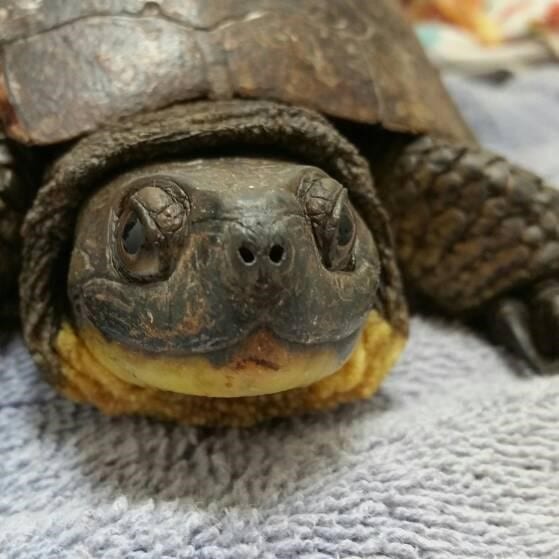
Blanding’s turtle will sleep in the daytime or during the evenings. Usually, after eating, these turtles will find a comfortable spot and sleep. In the wild, it is common to see adult males living in the same spot together. There may be around 10 to more than 50 turtles in a hectare, and usually, they bask together and sleep together. Blanding turtles will also overwinter and hibernate as a group. After hibernation, these turtles will start to breed.
Water
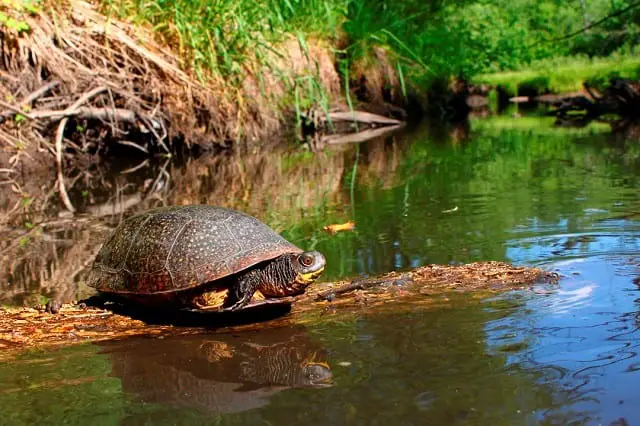
Blanding’s turtles can live on land an in shallow water where aquatic plants are found. These may also thrive in ephemeral wetlands to keep from predators that are common in wetlands. They use the grasslands or areas near water as shelter. Water habitats are from 35 to 105 cm deep and are comparable to the depth of water in the turtle’s non-overwintering areas which are 30 to 125 cm deep.
If you were to keep a Blanding’s turtle in captivity, consider an outdoor enclosure with a small pond. Add water plants in the pool so that your turtle/s can feed on these plants as well. If you can’t place your turtle outdoors, create an indoor enclosure with a water feature.
Keep in mind that turtles poop in the water, and thus regular maintenance is needed at least every day. Spot clean your tank for any poop on the substrate or water.
Development and Reproduction
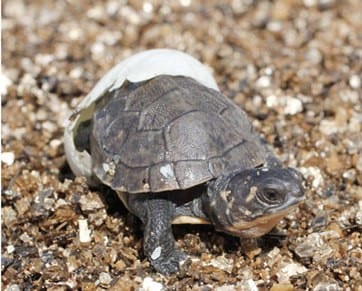
Just like other turtle species, Blanding’s turtles have temperature sex determination. When the mother lays her eggs in a cooler environment or near the water where its cooler, all the eggs in her next will be males. Meanwhile, eggs that are deposited in a warmer area, places that are far from the water, tend to result in male turtles.
Also, the time to hatch is affected by temperature. When eggs are deposited in an area where the temperature is warmer will hatch in 49 days. Eggs that are placed in a cooler area will hatch two weeks longer compared to eggs deposited in a warmer area.
Hatchlings are born measuring 29 to 39 mm and weighing only 6 to 10 grams. Shells of hatchlings are rounder but will become flat as they grow and age. There is also rapid growth in mass plus the length of their plastrons and carapaces grow as well.
The hatchlings’ abdominal plates will increase dramatically in just a year of life. These young turtles also experience slower growth over the next years, and in the fourth year of life, these Blanding turtles have reached their adult size.
The age of the turtles can be determined using the number of annuli found on their shells. The annuli are the rings found on the shells of turtles. Each ring or annuli is a year.
When the juvenile turtles are around 2 to 3 years of age, the hinges of their shells move but when these turtles reach their 5th year of life, the plastrons will completely close and will become hard. The shell length can reach 103 mm long, and the weight can be as much as 1400 grams.
Female Blanding’s turtles do not mature until they are 14 years old. Take note that a Blanding’s turtle can live for more than 75 years. During late May or early June, female turtles start to dig a nest in a sunny area where there’s good drainage. The female lays around 22 eggs in a nest. The hatchlings emerge from their eggs in the fall.
Reproduction
Female Blanding’s turtles are polyandrous, which means it has more than one mate. You can’t find a female who’s loyal to one mate, and it is also unknown if males mate with one or more females.
And because a clutch of eggs has more than one father, these are taken by multiple fathers. Usually only around two but there are also clutches taken by three fathers. The number of males that look after a nest depends on the number of turtles in a certain area. This multiple or shared parenting is also known as multiple paternity.
It is not certain as to what females look for when searching for the best mate. Females position her tail in a certain way telling a male that she chooses him. Females have complete control of the courtship, especially when it comes to choosing their mates.
However, males have full control during the courtship as they can be very aggressive. Males mount the females and hold on to the female’s carapace. The courtship starts underwater where the male aggressively mounts the female. The female may find this very stressful and may try to swim away. The male may chase the female, and usually, this behavior lasts for a minute.
As mating commences, the males will continuously move their heads up and down and release air bubbles. The mating process lasts for only a few seconds and takes place at night. Females will mate with the same males year after year.
Breeding can take place all year round, but usually, it starts to spring and ends in April. Female turtles will nest and lay eggs only once a year between June and July.
A unique feature of female Blanding’s turtles is sperm storing where they can store sperm in their bodies and use this to fertilize eggs when males are not available. A female creates a nest nocturnally and may take around 10 days to finish constructing their nest. During this period, the females also have to find the safest area to nest.
The most common area where Blanding’s turtle nest is along the shores of lakes, sides of roads or along cobble beaches. Sometimes it can take pregnant females another week more to search for the best nesting site. She can even travel more than 7.5 km as she searches for a suitable nesting site.
As soon as the mother finds a suitable nesting area, she will start building the nest. When the nest is done, she will now proceed to dig a hole which can be as deep as 12 cm. When the hole is finished, she will immediately lay her eggs in the hole and cover this by pushing the dirt back into the hole with its hind legs. A Blanding’s turtle will nest in the same spot every year. It is rare to find female turtles laying eggs on multiple nests.
The incubation period lasts from 80 to 128 days when the turtle is in the wild, but the incubation temperature is a crucial determining factor. Meanwhile, in captivity, incubation is only 49 days in 31 degrees Celsius and around 63 days when incubated at 26 degrees Celsius.
How to Breed
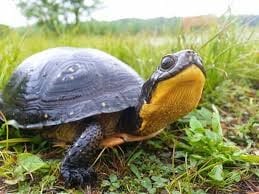
To breed Blanding’s turtles in captivity, it’s important to provide the conducive environment for your turtles to breed. First, you need a female and at least three males. You also need a large tank or an outdoor enclosure to accommodate four or more turtles.
Watch out for the turtle’s mating behavior. Make sure that the enclosure has a small water feature so your turtles can play and mate in the water. The water inside the enclosure also serves as an area where Blanding’s turtles can hibernate because these turtles hibernate underwater.
As soon as the turtles have successfully mated, mind the female as she builds her nest. Give her space where she can build a nest without worry. As females tend to choose the ideal place to build her nest, you may now determine if she has male or female offspring.
Support the female by providing her a good diet high in protein and lots of fresh, clean water. Consult a vet regarding the ideal supplement for female turtles.
Common Health Problems
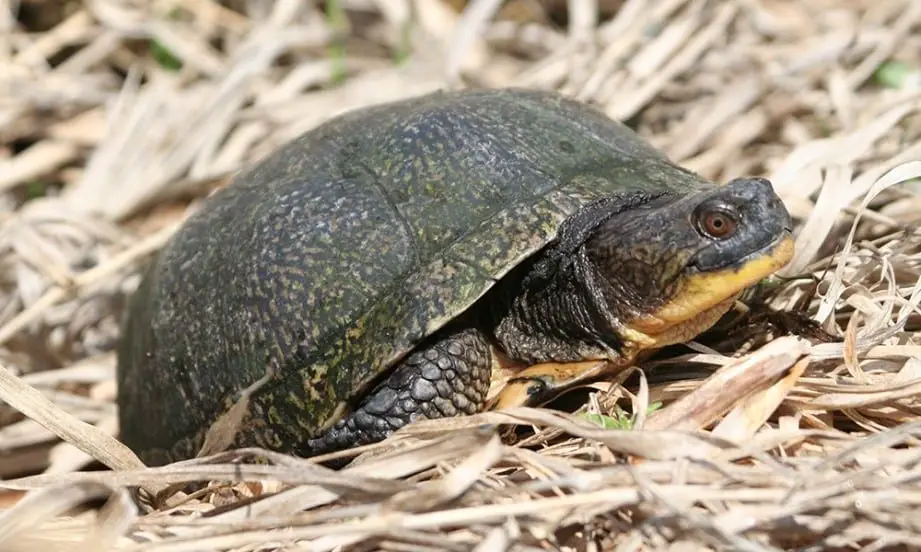
Blanding’s turtle may occasionally suffer from health issues. For any health concerns, consult a vet for prompt and effective treatment.
Respiratory Infections
Blanding’s turtle can suffer from respiratory conditions due to bacteria and due to vitamin A deficiency. Signs include open-mouth breathing, wheezing, poor appetite and lethargy. You may also notice a discharge from the nose, which is a sign that it needs medical treatment right away.
Shell Problems
Shell problems are common in turtles and are usually due to bacterial or viral infections and fungi. When these are overlooked, the shells can crack and fracture. Females may also suffer from shell problems after aggressive mating. You must watch out for physical injuries as well as bleeding, abscess, and poor healing if the shell injury happened many weeks or months ago.
Abscesses
Abscesses are any kind of swelling or any tumor-like growth on any part of the turtle’s body. The most common sites for abscesses in larger turtles are the eyes and the opening of the ear. Vitamin A deficiency is the leading cause of abscesses in most turtles.
Vitamin A Deficiency
Vitamin A deficiency is a diet that lacks the vitamin, and this results to skin changes, poor appetite, swelling of the eye and the lids, swelling of the ears, respiratory conditions and lack of energy. Feed your turtle a vitamin A-rich diet or provide supplements because even a diet composed of crickets, fruits, vegetables are all insufficient sources of vitamin A.
Parasites
If your turtle suddenly has bouts of diarrhea and weight loss, it may have intestinal parasites. Roundworms are the most common in turtles, and this must be treated right away. Usually, turtles don’t show any symptoms and only diarrhea and weight loss.
Turtle Injuries
Blanding’s turtles are larger than other pet turtles and thus are usually kept in an outdoor enclosure. But as it stays outdoors, it can be prone to many kinds of accidents. Your turtle may fall and break its shell, and as the shell breaks, it may suffer from serious injuries. For any injury, take your pet to the vet ASAP.
If you see the injury on the eyes, nose or the head and there is bleeding, visit the vet immediately. If there is vomiting, loose stools or blood in stools, take your pet to the vet to prevent dehydration, loss of blood, and other metabolic problems.
If there are injuries on its skin, head, shell or eyes, take your turtle to the vet. Wash the wound with water and cover it with a sterile gauze or bandage and take it to the vet.
Preventing Illness
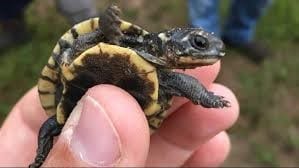
The best way to prevent illness is to maintain tank cleanliness. Change the water inside the tank once every week. You may also use a powerful water filter to efficiently clean the water in the tank. Remember to change the filter often.
Use a powerful disinfectant and warm water. Change the water frequently to avoid the growth of bacteria. Remove any food remnants in the tank as well as poop; spot clean every once in a while.
Take your turtle to the vet for regular checkups. Do this more frequently when your turtles are in their hatchling phase. Talk to your vet about the best food and supplements for your pet. Always maintain the best temperature inside the tank to prevent illness because of incorrect temperature and humidity. Finally, consistently monitor the temperature, humidity, and water quality inside the tank.
Behavior
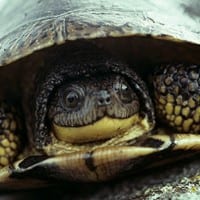
To fully care for your Blanding’s turtle, you must understand its common behaviors. Here are the most common:
Head bobbing
A Blanding’s turtle will bob its head up and down during mating. It will do so as it mounts the female and taking her underwater. Although this happens just a few seconds, it is important to note this because it’s a good sign that the female has chosen a mate.
Sleepiness
Sleeping most of the day is common in turtles, and usually, first-time pet owners become alarmed thinking that they have a sick pet. Turtles have bouts of energy and like us, may feel sleepy after a meal and may feel active in the morning. And like humans, young Blanding’s turtles are also very active, but this energy declines as the turtle reach his senior years.
Keep a diary of your pet’s behavior and if it sleeps all day with poor appetite and weight loss, then suspect that there’s something with his health. Take him to a vet to rule out any illness.
Mating behavior
Females mate with more than one male, and therefore she may lay a clutch of eggs coming from multiple fathers. She controls the courtship side of the mating season as she gets the chance to pick her mates.
Meanwhile, males control the mating side as they can become very aggressive when mounting a female. Sometimes this becomes too aggressive that she might suffer from injuries while mating.
Shared male parenting
Another weird yet lovable behavior in Blanding’s turtles is that males tend to share the workload of taking care of nests. They may stay near the nesting site and guard eggs against possible predators. Whether or not they have fathered the eggs in a clutch, males remain and keep a close watch.
The same nest
Females are very particular about their nesting site in such a way that they will come back again come breeding season to lay their eggs there. Often, this is a sight for tourists as they check out a turtle nest in the sand. They would predict that on the next breeding season, this female will come back if she has successfully mated with a male. This unique behavior among females is also seen in other turtle species.
Basking
Turtles like the Blanding’s turtle can sit or stand still and just enjoy basking in the sunlight or under a tank light. Sometimes they would open their mouths, smile, stick their head out just to get more light. Turtles may also bask together or as a group. You can see them mostly near riverbanks or near ponds together on a log or a large rock.
Hibernation underwater
Brumation is similar to hibernation, and turtles will be inactive and sleeping more than the usual. This happens during colder months. You can tell that a turtle is brumating when they don’t each much and don’t defecate either.
Turtles in brumation appear motionless and have a very slow heart rate and respiration. Some turtles brumate underwater but may also choose near the water bank, in tree stumps, rocks and other structures near water. Brumation is an adaptive mechanism to protect its body from the long harsh cold months. Some turtles can survive anaerobically for many weeks during brumation. It can decrease its metabolic rate with their cardiac output dropping up to 80% to reduce energy requirements. Blanding’s turtles hibernate too, and sometimes this can happen underwater.
Turtles can also drown
Turtles can remain underwater for a very long time but may also drown. Turtles need to come up for air to breathe, but if they cannot, they can drown.
If you suspect that your turtle has drowned, do not turn it upside down because there may still be air left inside their lungs. Doing this can reduce their chance to recuperate. To revive a drowning turtle, place it on a flat surface and gently do a simple turtle CPR.
Gently hold its two front legs and push these in and out the body or shell. If there is water in the lungs, this can remove water out. Water may come out of its mouth and nose. After this, take your pet to the vet. Wrap it in a towel and take it to the vet at once.
Habitat
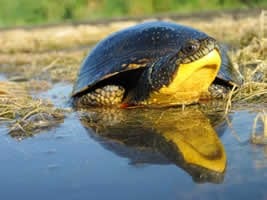
Blanding’s turtle is found in North America and along the Great Lakes. These have certain habitat requirements, and this depends on the turtle’s age and season.
During the spring and summer, these turtles are found in wetlands, shallow lakes, ponds and river with vegetation. You’ll find them basking on logs and rocks usually when the air is cooler. Once Blanding’s turtles are 20 years old, these will reproduce and will remain in vegetated habitats near water. Females will also prefer to mate in these areas.
Considering these environmental requirements, you should prepare a tank or enclosure that’s in line with your turtle’s needs. Also, prepare a shallow water tank, a mini lake, inside the enclosure so turtles can have a dip.
Blanding’s turtles are threatened species
In North America and all over the world, Blanding’s turtles, as well as freshwater turtles, are threatened species. Seven out of eight species of freshwater turtles found in Ontario are now threated or endangered, and major conservation efforts are being made.
Major threats to the population of Blanding’s turtles include illegal pet trade, habitat loss, fragmentation, and egg predation. Turtles are also observed to have slower reproduction rates, and together with the mentioned factors, Blanding’s turtle’s population has severely declined.
Habitat loss and fragmentation are the most common threats to the turtle’s population. Land that turtles inhabit is being destroyed for land development and industrialization. Blanding’s turtles have specific habitat requirements and may not be able to move in great distances. These may not survive if habitat destruction. Roads are the most common worries for Blanding’s turtles. Usually, females try to cross a road that has been placed near her habitat only to get hit and killed by vehicles.
The rise of illegal pet trade has also reduced wild populations of Blanding’s turtles. Indeed, this turtle makes a cute pet, but in the hands of an inexperienced pet owner, these turtles may not survive at all. More so, poachers find it easier to capture turtles to sell in pet shops. These people can go as far as digging a female’s nest and getting all her eggs!
Finally, Blanding’s turtles are also the target of predators. Their eggs are often dug by foxes, raccoons, and coyotes and eaten. This can also contribute to the decline of the turtle’s population.
Lighting
Use a full-spectrum UV lamp and a basking heating lamp inside the turtle’s enclosure. There are many types of lamps and heaters, but the best one has to be an LED light. This type of lamp can provide good light but will not make the tank too hot for your pet. This light is also energy efficient and will last longer.
Ideally, your lighting must be adjustable with temperature adjustments and height adjustments. Also, most experienced growers have a spare battery-powered lamp in case of power outages. You should never overlook this because low temperatures can affect your turtle’s health.
Temperature
The turtle enclosure must be well heated. Use a reliable lamp and a heating pad to maintain the temperature inside the tank. Monitor tank temperature and humidity always. To correct low humidity, add a pan of water inside the tank or use a mister to spray water on the walls of the tank. Finally, keep the turtle tank clean and at the right temperature, especially when the temperature drops.
Filtration
Use a reliable filter that will continuously clean tank water. The tank water can easily become dirty if you have more than one turtle inside the tank or enclosure. Remember to have a battery-powered backup filtration unit in case of power outages. Consider spot cleaning the water inside the enclosure because just like any turtle, Blanding’s turtles can poop in the water.
Tank Accessories
Keep the turtle enclosure simple and clean. Avoid any décor that can injure your pet. The tank only needs water, soil, sand, and a few rocks where the turtle can sit on. Meanwhile, females with eggs need more loose soil inside the tank or enclosure. This will help her lay her eggs safely. Avoid anything that can fall on your pet or anything that can tangle or electrocute your turtle.
Sanitation
Keep the tank clean to prevent the spread of dangerous parasites. Small turtles can spread Salmonella, a dangerous bacteria which can cause diarrhea, vomiting, and other symptoms in humans. Clean the tank regularly, every week especially if you have more than one turtle.
You must use a disinfectant to clean the tank well. Use warm water and rinse the tank. For an enclosure, brush the floors and walls and hose it down. Wash your hands or wear protective gear when cleaning a turtle enclosure. Make sure everything is dry and ready before you place your precious turtle inside the tank.
Availability – Where to Get One?
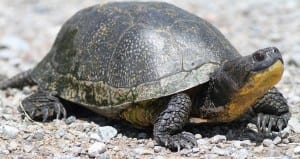
Blanding’s turtle is available in exotic pet shops and pet stores, but we strongly advise not to get one as a pet to discourage illegal pet trade. If you want to help stop pet trade, adopt a turtle from a friend and don’t buy from traders, pet shops or exotic stores.
Blanding’s turtle’s hatchlings are sold around $300 depending on the gender. Shipment and handling costs depend on where you’re located, so this is certainly a very costly pet. Adopting a Blanding’s turtle will cost nothing plus you’re helping efforts to save this creature by not supporting poachers and the illegal pet trade.
How to Care for a Blanding’s Turtle?
Here are some tips on how to care for a red-eared slider:
- When handling Blanding’s turtle, wash your hands to avoid the spread of Salmonella and other diseases. Blanding’s turtles may be affected by parasites so don’t spread it to other pets as well.
- This turtle doesn’t mind being handled a lot, just do so carefully. Don’t drop them or place them in a cold environment.
- Blanding’s turtles may be allowed to roam the yard or outdoors as long as you protect it from predators. You can use a small cage that may be carried anywhere. Take a portable lamp, water, and turtle food with you if you want to take it on a trip.
- Monitor the temperature of the tank or enclosure. Keep the turtle tank’s temperature perfect by using a bright light or reptile lamp in case there’s no sunlight.
- Keep your turtle healthy by taking it to a vet regularly. Do this more often when your pet is young and during its senior years.
- Always monitor your pet for any problems such as breathing problems and shell conditions. For new turtles, don’t immediately place it inside the tank or enclosure. Place it under quarantine to rule out any diseases just for a few weeks before you allow it to join your turtles in the tank.
- Feed your turtle the right kind of food. This will prevent deficiencies and infections. Consult a vet for the ideal type of food according to your turtle’s developmental stage.
FAQs
Why are Blanding’s turtles endangered?
The Blanding’s turtle is a threatened species of freshwater turtles because of several reasons. The illegal pet trade, destruction of their natural habitat, and predation are three of the most common causes.
How long will the eggs of a Blanding’s turtles hatch?
The incubation of Blanding’s turtle’s eggs may vary according to the temperature of the nest. Usually, it can take 80 to 128 days; cooler nests can make incubation longer while warmer nests can make incubation shorter.
How long do Blanding’s turtles live?
Blanding’s turtles can live up to 80 years in captivity. This is a threatened species of freshwater turtles and may not survive unless conservation efforts are successfully met.
What kind of animal will eat a Blanding’s turtle?
The turtle has many predators being a medium-sized turtle. Coyotes, foxes and other large hungry mammals can take their eggs and eat them once they discover the nests; they may also eat adult turtles because these are slow-moving land animals.
Is it illegal to sell and buy Blanding’s turtles?
Currently, there are measures to ensure that Blanding’s turtles are protected, but the trade continues. It is now illegal to sell these turtles openly, and most that get them as pets buy from illegal traders.
Can you leave a Blanding’s turtle in your yard?
Yes but not completely alone in the yard. Install a fence over the area where it can roam around and place a small pool where it can splash around and enjoy the water.
Can you get a Blanding’s turtle from the wild?
It is not a good idea to get a Blanding’s turtle from the wild because this encourages poaching. You can also get parasites from wild turtles and other reptiles.
Can you feed fish to Blanding’s turtles?
Yes, fish is included in the Blanding’s turtles diet. If you have a pet turtle and is still young, you can cut the fish in small cubes to feed it. But encourage variety in his diet and include fruits and veggies as well.
Can Blanding’s turtle’s bite?
Yes, Blanding’s turtles may bite when it feels threatened just like other reptiles. But usually, it is very docile and will never fight unless it’s provoked.
Can Blanding’s turtles live with other turtles in an enclosure?
With the same species yes, they are often found in groups near water basking together. But with other turtle species, no. Use different tanks or enclosures to house different species as these have different needs and environmental factors to consider.
Are Blanding’s turtles territorial?
No, Blanding’s turtles are social animals. Males will even co-parent as they guard females’ nests.

